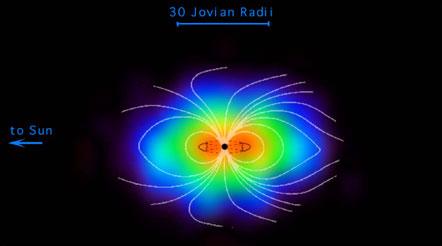Jupiter’s Magnetosphere

| PIA Number | PIA03476 |
|---|---|
| Language |
|
Jupiter's Magnetosphere Made Visible
February 27, 2002
The vast magnetosphere of charged particles whirling around Jupiter, normally invisible, can be imaged by a new type of instrument aboard NASA's Cassini spacecraft and is seen here.
Three features are sketched in for context: a black circle showing the size of Jupiter, lines of Jupiter's magnetic field, and a cross-section of the Io torus, a doughnut-shaped ring of charged particles that originate from volcanic eruptions on Jupiter's moon Io and circle Jupiter at about the orbit of Io.
Jupiter's magnetosphere is the largest object in the solar system. If it glowed in wavelengths visible to the eye, it would appear two to three times the size of the Sun or Moon to viewers on Earth.
Cassini's ion and neutral camera detects neutral atoms expelled from the magnetosphere, deriving information about their source. This image was taken shortly after Cassini's closest approach to Jupiter, about 10 million kilometers (6 million miles) from the planet on Dec. 30, 2000. For more information about the Saturn-bound spacecraft and its observations of Jupiter, see the Cassini home page, http://saturn.jpl.nasa.gov.
Cassini is a cooperative project of NASA, the European Space Agency and the Italian Space Agency. The Jet Propulsion Laboratory, a division of the California Institute of Technology in Pasadena, manages the Cassini mission for NASA's Office of Space Science, Washington, D.C.
Credit: NASA/JPL/Johns Hopkins University Applied Physics Laboratory
More information about the Cassini and Galileo joint observations of the
Jupiter system is available online at:
Cassini is a cooperative project of NASA, the European Space Agency and the Italian Space Agency. The Jet Propulsion Laboratory, a division of the California Institute of Technology in Pasadena, manages the Galileo and Cassini missions for NASA's Office of Space Science, Washington, D.C.
For higher resolution, see http://photojournal.jpl.nasa.gov/catalog/PIA03476.
